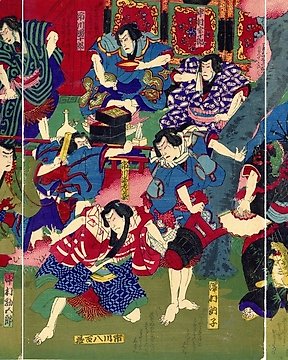
Triptyque original imprimé sur bois - Papier - Taguchi Toshinobu 田口年信 (1866-1903) (Kuniume 国梅 or Yamazaki Toshinobu II) - 'Yakusha mitate hanami sumai shusse no nigiwai' 役者見立花見角出世賑 - Japon - 1886 (19 Meiji)
Nº 84048875

Nº 84048875

Original woodblock print triptych - Paper - Ogata Gekko (1859-1920) - “Nisshin sensō Hōōjō dai shōri no zu” 日清戦争 鳳凰城大勝利図 (Great Victory at Fenghuangcheng) - Japan - 1894 (Meiji 27)
Publisher by Takegawa Tonesaburou 武川利根三郎
The triptych depict the fall of Fengcheng Fortress in Liaoning to the Japanese army during the -Qing Japanese war of 1894-95.
Also, since it is old, there are stains and marks on the tape. There is a tape mark on the back of the woodblock print (the prints are secured together). Paper losses and creases
The signature says “Gekko”月耕”.
Gekko often works on works that have a sense of life and are based on everyday life and festivals. The work he exhibited this time is one of them.
The signature is ‘Gekko’ 月耕
Gekko was a disciple of Kikuchi Yosai.
Therefore, unlike the Ukiyo-e artists of Tsunobu, Yoshitoshi, and Kunisada.
Kikuchi Yosai learned Japanese painting from Tosa(土佐派) and Shijo(四条派) painters.
Gekko learned painting from Yosai, so his style is also influenced by it.
memo
He was born as Nakagami Shōnosuke (名鏡 正之助) in Kyōbashi Yazaemon-chō in Edo (modern Tokyo) in 1859.
Gekkō was self-taught in art, and began decorating porcelain and rickshaws, and designing flyers for the pleasure quarters.
From the 1890s Gekkō won a number of art prizes, both national and international. He was one of the earliest Japanese artists to win international attention. At the World’s Columbian Exposition in Chicago in 1893 he won a prize for Edo Sannō matsuri (江戸山王祭, “Edo’s Sannō Festival”), and in 1904 he won the Gold Prize for the series Fuji hyakkei (富士百景, “One Hundred Views of Mount Fuji”) at the Louisiana Purchase Exposition. His work was exhibited at the Exposition Universelle in Paris in 1900 and at the Japan-British Exhibition in London in 1910.In 1898 at the Japan Art Association, Emperor Meiji bought his painting Soga yo-uchi (曽我夜討, “Night Attack of the Soga”). He won third prize at the sixth Ministry of Education Art Exhibition in 1912.
See Museum of Fine Arts, Boston: https://collections.mfa.org/objects/129915
Comment acheter sur Catawiki ?
1. Découvrez des objets d’exception
2. Faites la meilleure offre
3. Effectuez un paiement sécurisé